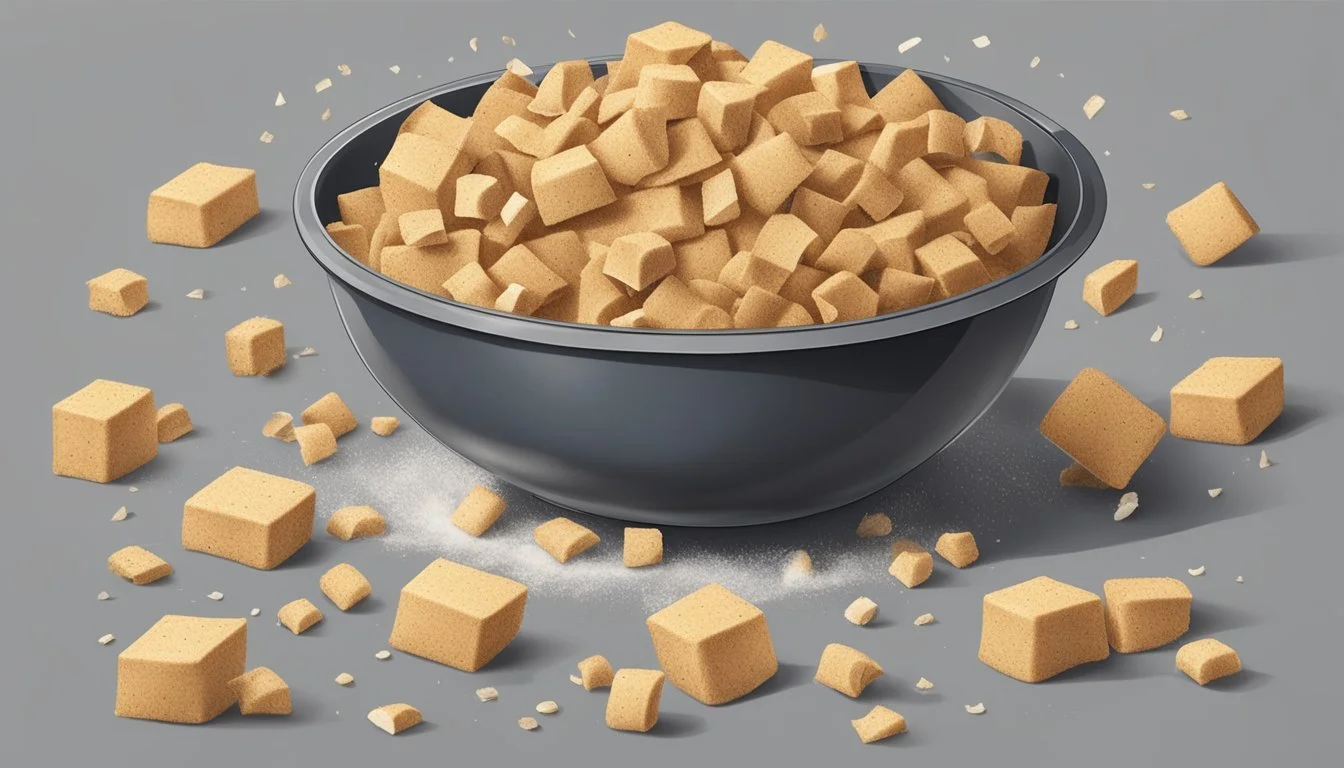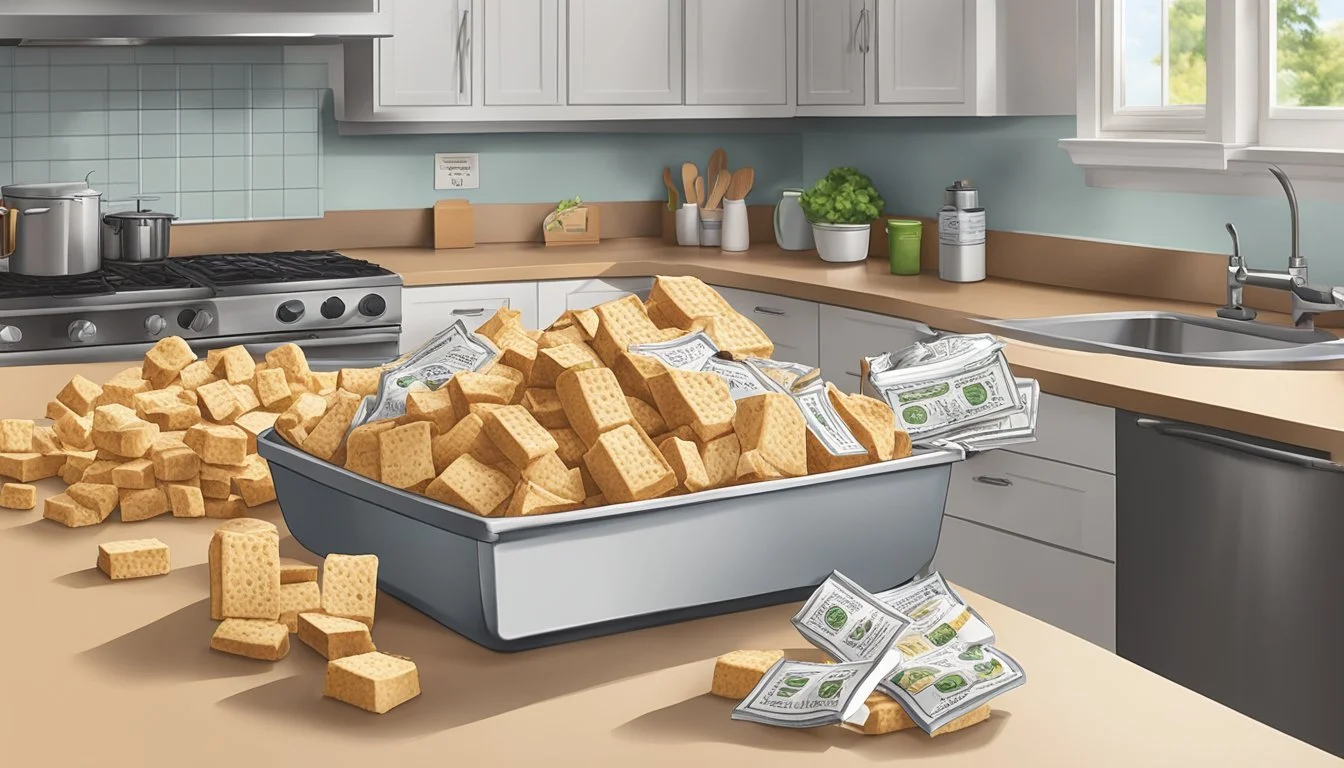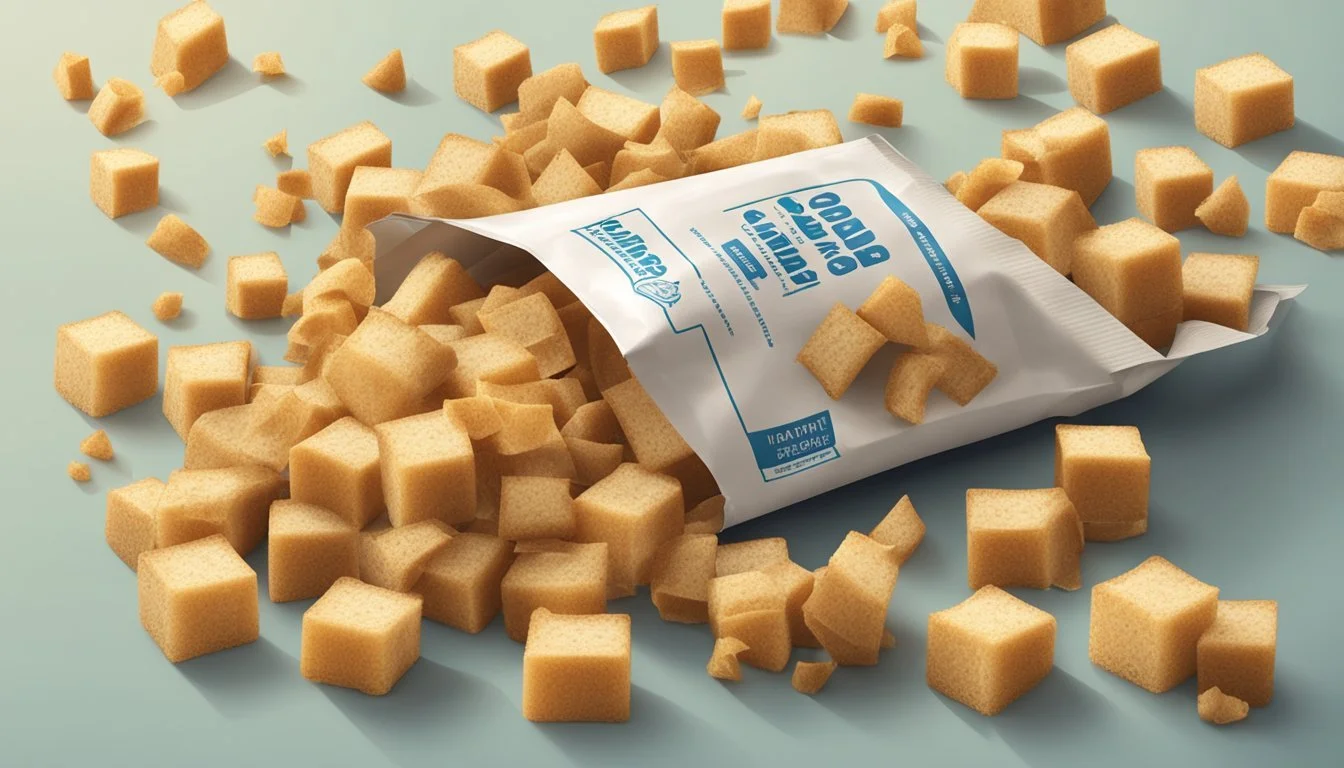Is it Safe to Eat Expired Croutons?
Understanding Food Expiration Dates
When it comes to expired croutons, many consumers question their safety and whether they are still suitable for consumption. Croutons are known for their crispy texture and ability to add a satisfying crunch to salads and soups. They are small pieces of seasoned, rebaked bread, and like many dry goods, they have a relatively long shelf life. However, the preservatives in croutons that help maintain their freshness can only do so for a certain period before the quality begins to deteriorate.
The safety of eating expired croutons largely depends on their storage conditions and the passage of time since their expiration. Typically, croutons are quite shelf stable; however, when they surpass their expiration date, their quality can be expected to decline. If stored improperly, croutons are subject to moisture which can lead to staleness or, worse, the growth of mold. It's crucial to inspect the croutons for any visual signs of mold or an off-smell which clearly indicate spoilage. As long as expired croutons don't exhibit these signs, they are generally considered safe to consume, but the taste and texture may not be as pleasant as when they were fresh.
It's also worth noting that the term "expiration date" can sometimes refer to a "best by" date, which is the manufacturer's estimate of when the product will start to decrease in quality, rather than when it becomes unsafe. Thus, croutons past their "best by" date may still be safe to eat if they pass a sensory evaluation for smell and taste. Consumers should use their judgment and prioritize food safety, considering whether the potential decline in sensory qualities aligns with their personal standards for consumption.
Understanding Expiration Dates
When navigating the safety of consuming expired food items, understanding the distinction between an expiration date and the actual shelf life of a product is critical. This especially applies to dry goods such as croutons, where the label's date might not wholly indicate the product's viability.
Expiration Date Versus Quality
The expiration date on a food package is often perceived as the final date the product is safe to consume. However, this date is more commonly a suggestion for when the product will be at its peak quality. After this date, while the taste or texture may degrade, the product might still be safe to eat if it has been stored properly. For croutons, which are essentially dried and seasoned bread, moisture content is a key determinant of quality. A dried product like croutons is less susceptible to microbial growth than moist foods, thereby extending its edible period beyond the expiration date.
Shelf Life of Croutons
The shelf life of croutons can be influenced by several factors including packaging, preservatives, and storage conditions:
Homemade croutons: Typically last up to 2 weeks when stored at room temperature in an airtight container.
Packaged croutons: Can last for an additional 6 to 8 months past the labeled expiration date if unopened and stored in a cool, dry place.
Once opened, the shelf life reduces and croutons should be used within 1 month to ensure freshness.
Labeling homemade croutons with a date helps track how long they have been stored, while for store-bought, the printed expiration date helps determine how long they have been on the shelf.
Storing croutons in the refrigerator or freezer can further extend their shelf life, but this is not typically necessary unless the environment is very humid or the croutons contain additional perishable ingredients.
Factors Influencing Crouton Freshness
Crouton freshness is affected by several factors such as moisture levels, exposure to light and air, and storage methods. Understanding these factors can help maintain the quality of croutons after their package has been opened.
Moisture and Staleness
Moisture is the enemy of crouton freshness. When croutons absorb moisture from the environment, they become soggy and stale. Fresh croutons should have a crisp texture, and once they lose that quality, they are no longer at their peak freshness. It is essential to keep croutons dry to maintain their crispness.
Effect of Light and Air
Exposure to light and air can compromise the integrity of croutons. Light can accelerate the degradation process, and air can introduce moisture and microbial spoilage. Croutons are best maintained in a dark and cool environment, away from direct light, and sealed off from the air to preserve their texture and flavor.
Storing Croutons Properly
Airtight containers are the best choice for prolonging the crispness of croutons. Whether store-bought or homemade, croutons should be stored properly to avoid spoilage. The following methods are recommended for storing croutons:
Pantry: Place croutons in an airtight container and keep them in a cool, dry place.
Refrigerator: While not necessary, can extend freshness for a short term use.
Freezer: For long-term storage, seal croutons in freezer-safe bags or containers.
To review, proper storage is critical for maintaining the freshness and edibility of croutons. An airtight container, away from moisture, light, and air, will help keep croutons fresh and enjoyable for their maximum shelf life.
Identifying Spoilage
When assessing whether croutons have gone bad, both visual cues and the sense of smell can be reliable indicators of spoilage.
Visual and Odor Clues
Mold Growth: One should discard croutons if they spot any mold, which typically appears as fuzzy green or white spots. Mold growth indicates the presence of harmful bacteria, and consuming moldy croutons poses health risks.
Odor: Croutons that give off a rancid or strong smell should not be consumed. Such an odor often arises when the fats within the croutons have begun to spoil, signaling that the product is no longer safe to eat.
Texture and Flavor Changes
Texture: Fresh croutons should retain a crunchy texture. A notable change to a chewy or soggy texture suggests loss of quality and potential spoilage.
Flavor: If the typically savory and salty flavor of croutons develops an off or stale taste, this alteration is indicative of potential spoilage and the croutons should not be consumed.
It's important to consider these sensory evaluations alongside the expiration date to make an informed decision about the edibility of croutons.
Food Safety Considerations
When considering whether expired croutons are safe to consume, it is crucial to assess both the potential health risks associated with spoiled products and the best practices to ensure safe consumption.
Health Risks of Spoiled Croutons
Croutons that have spoiled can pose health risks to consumers. Spoilage occurs when croutons have been exposed to moisture or are stored improperly, which can lead to the growth of bacteria or molds. Food poisoning can result from ingesting these harmful organisms. Symptoms of food poisoning might include nausea, vomiting, and diarrhea. To reduce risk, it is important to inspect the croutons for any signs of mold, off odors, or unusual textures, which may indicate spoilage.
Best Practices for Safe Consumption
To ensure croutons are safe to consume, follow these best practices:
Expiration Dates: Use the expiration date as an initial guide, but assess croutons further if they're past this date.
Storage: Store croutons in a cool, dry place away from direct light. Sealed containers can extend their shelf life.
Inspection: Before using expired croutons, examine them visually for mold, and smell them for any off odors.
By adhering to these practices, consumers can mitigate potential health risks and safely enjoy croutons even after the expiration date, provided they show no signs of spoilage.
Proper Storage Techniques
Proper storage is crucial to extend the shelf life of croutons and maintain their quality. Methods such as using airtight containers and understanding the appropriate storage environment can significantly impact the longevity of croutons.
Storing in Pantry and Cupboard
When storing croutons in a pantry or cupboard, it is essential to keep them in an environment that is cool and dry. The ideal storage method involves:
Airtight Containers: Seal croutons in airtight containers to prevent moisture from making them soggy.
Counter or Cupboard: Place the container in a dark and cool area, away from heat sources like the stove or direct sunlight.
Resealable Bags: If the original packaging is opened, transfer the croutons to resealable bags to maintain freshness.
Refrigeration and Freezing Options
For a longer storage period, croutons can also be kept in the fridge or freezer. Here's how to do it:
Refrigeration:
Keep croutons in an airtight container or a resealable bag to protect from the fridge's moisture.
This method works best for homemade croutons, extending their shelf life to about three days.
Freezing:
Place croutons in a freezer-safe airtight container or resealable bag to avoid freezer burn.
Freezing croutons can extend their usability for up to four weeks, retaining their texture and flavor upon thawing.
Remember, the key to effective storage, whether in the pantry, fridge, or freezer, is to minimize the croutons' exposure to air and moisture, thus reducing the risk of them turning stale or becoming unfit for consumption.
Tips for Using Older Croutons
When croutons pass their peak freshness, it doesn’t mean they need to be discarded. There are ways to rejuvenate stale croutons and integrate them into dishes, enhancing flavors and adding a pleasing crunch.
Reviving Stale Croutons
If one finds their croutons have become stale, they can be freshened up with a bit of heat. Placing stale croutons in an oven for a few minutes can help to revive them. The oven should be preheated to 300 degrees Fahrenheit before spreading the croutons evenly on a baking sheet. Heating them for 5 to 10 minutes can help to toast them back to a desirable crispness. However, one should keep a close eye to ensure they don't burn.
Creative Culinary Uses
Stale bread doesn’t mean the end of the line, especially for older croutons. Instead, one can consider:
Breadcrumbs: Crush the croutons and use them as breadcrumbs in various recipes like a crispy coating for fried foods or as a binder in meatloaf.
Soups and Stews: Add texture to liquid-based meals like soups and stews by sprinkling in crushed croutons.
Casseroles and Pasta Dishes (What wine goes well with pasta dishes?): A topping of slightly stale, crushed croutons gives casseroles and pasta dishes a crunchy texture.
The key is to use these older croutons in a way that their texture can be an asset, not a liability, to the dish. Whether softened in a broth or added for a crisp element, older croutons can find a second life in a variety of culinary contexts.
Frequently Asked Questions
When it comes to croutons, understanding shelf life and storage techniques ensures both safety and taste. This section addresses common inquiries regarding the lifespan and preservation of croutons.
How Long Do Croutons Last?
Homemade croutons typically remain fresh for up to two weeks when stored at room temperature in an airtight container. Store-bought croutons, due to preservatives, often have a longer shelf life and can last several months unopened. Once opened, both homemade and store-bought croutons are best consumed within a month to maintain optimal crunch and flavor.
Can You Freeze Croutons?
Freezing can extend the shelf life of croutons. To freeze, one should place the croutons in a freezer-safe airtight container or a sealable plastic bag. Frozen croutons can last for up to four weeks. It's important to label the container with the freeze date to track how long they have been stored.
What Are the Signs of Bad Croutons?
Croutons that have gone bad may exhibit several signs:
Moldy appearance: Visible mold growth signals spoilage.
Off-odor: Any unpleasant or sour smell is an indication that they should not be eaten.
Changed texture: If croutons lose their characteristic crispness and become chewy or soggy, they're past their prime.
Taste test: If the taste significantly deviates from their original flavor, or if they taste stale, they should be discarded.
To ensure safety and enjoy croutons at their best, one should always rely on these indicators before consumption.
Conclusion
Expired croutons, while not posing a significant health risk, are generally not recommended for consumption. Preservatives within croutons can prolong their shelf life, but once past their expiration date, freshness can be compromised, affecting texture and flavor.
When assessing croutons beyond their expiration date, one should conduct a smell and taste test.
If the croutons have a stale taste or an off-odor, they should be discarded.
Croutons are a popular garnish for salads, and therefore their quality can impact the overall dining experience.
While some sources suggest that expired croutons can still be consumed without health risks, it is safer to err on the side of caution by discarding them if any signs of spoilage are present. Furthermore, the diminished quality of stale croutons could detract from the enjoyment of the dish they accompany.
In conclusion, to ensure the best culinary experience and to maintain food safety standards, one is advised to use croutons before their expiration date or to replace them if they show signs of being past their prime.








